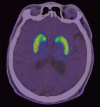Two Siblings with Adolescent/Adult Onset Niemann-Pick Disease Type C in Korea
- PMID: 27366019
- PMCID: PMC4901013
- DOI: 10.3346/jkms.2016.31.7.1168
Two Siblings with Adolescent/Adult Onset Niemann-Pick Disease Type C in Korea
Abstract
Niemann-Pick disease, type C (NP-C), is caused by NPC1 or NPC2 gene mutations. Progressive neurological, psychiatric, and visceral symptoms are characteristic. Here, we present cases of a brother (Case 1) and sister (Case 2) in their mid-20s with gait disturbance and psychosis. For the Case 1, neurological examination revealed dystonia, ataxia, vertical supranuclear-gaze palsy (VSGP), and global cognitive impairment. Case 2 showed milder, but similar symptoms, with cortical atrophy. Abdominal computed tomography showed hepatosplenomegaly in both cases. NPC1 gene sequencing revealed compound heterozygote for exon 9 (c.1552C>T [R518W]) and exon 18 (c.2780C>T [A927V]). Filipin-staining tests were also positive. When a young patient with ataxia or dystonia shows VSGP, NP-C should be considered.
Keywords: Ataxia; Dystonia; Hepatosplenomegaly; Niemann-Pick Disease, Type C; Oculomotor Paralysis; Psychosis.
Conflict of interest statement
Figures



References
-
- Garver WS, Francis GA, Jelinek D, Shepherd G, Flynn J, Castro G, Walsh Vockley C, Coppock DL, Pettit KM, Heidenreich RA, et al. The National Niemann-Pick C1 disease database: report of clinical features and health problems. Am J Med Genet A. 2007;143A:1204–1211. - PubMed
-
- Imrie J, Dasgupta S, Besley GT, Harris C, Heptinstall L, Knight S, Vanier MT, Fensom AH, Ward C, Jacklin E, et al. The natural history of Niemann-Pick disease type C in the UK. J Inherit Metab Dis. 2007;30:51–59. - PubMed
-
- Chang TY, Reid PC, Sugii S, Ohgami N, Cruz JC, Chang CC. Niemann-Pick type C disease and intracellular cholesterol trafficking. J Biol Chem. 2005;280:20917–20920. - PubMed
-
- Vanier MT. Lipid changes in Niemann-Pick disease type C brain: personal experience and review of the literature. Neurochem Res. 1999;24:481–489. - PubMed
Publication types
MeSH terms
Substances
LinkOut - more resources
Full Text Sources
Other Literature Sources
Medical
Miscellaneous

